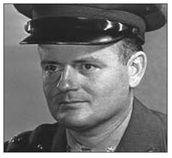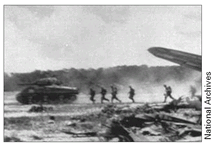War Stories II (53 page)
Authors: Oliver L. North

He ordered the 7th Marines to shift the orientation of their attack and seize the airfield. Major Gordon Gayle was acting commander of the 1st Battalion, 7th Marines during the assault on the airfield. It would turn into a “run and gun” tank-infantry battleâa first for the Marines.

MAJOR GORDON GAYLE, USMC
1st Battalion, 7th Marines
Peleliu, Palau Islands
21 September 1944
1st Battalion, 7th Marines
Peleliu, Palau Islands
21 September 1944

When I joined the Marine Corps, it was the size of the New York City police force. When the war was over, the Corps was half a million strong.
We went to Guadalcanal in '42, came out of New Guinea in '43. We landed in New Britain and came out in May of '44. It was hot, but not as hot as Peleliu.
After we left New Britain and went down to Pavuvu, a ship came in with replacements. I went down to watch our people leave and watch the new people come off the ship, and the contrast was just mind-boggling. The veterans who were leaving to become the cadre of new units forming up were all thin, lean, sharp-eyed, and walked on their toes, and they were tan.
The new guys coming off the ship were relatively white and heavy, walking on their heels. It was really one of the more impressive experiences that I had during the war. It wasn't anything you could talk about, because you didn't want to tell the troops that they didn't look ready, but it made a terrific personal impression.
My battalion landed on Peleliu in support of the two assault battalions of the 5th Regiment. The 5th Regiment was to land with the 1st Marines on their left and 7th Marines on the right.
It didn't surprise me that we were going to have bitter resistance. Some of the naval officers seemed to think that their bombardment had destroyed everything there and, Colonel Puller was told by the captain of his ship, “I'll see you back here for dinner.”
I went ashore in an Amtrac. And as we went in, you could see other LVTs burning on the beach. You could see Marines lying on the beach, and a lot of pandemonium.
There were a lot of mines, and the Japanese had attempted to rig up log obstacles. The tetrahedrons were down on other beaches, but they weren't on our beach. The obstacles didn't create any particular problem of moving the tractors in or getting out of them and running to shore. It's just that there was a fair amount of fire.
I ordered my troops to move out as fast as they could. Our mission was to go through the two assault battalions and cross the airfield. And I told everybody, “Understand that the nice, comfortable trench that the Japanese dug alongside the airfield will be well registered by their guns, so don't go there.”
We expected the airfield to be defended in depth. And all of those expectations came true. We had been warned that they had tanks, and about mid-afternoon, the Japanese launched a tank and infantry attack across the airfield.
I was in a bomb crater with my intelligence officer. I said, “Send our tanks after them.” I had a platoon of five Sherman tanks, and I sent them into the fight. And they just knocked the Japanese tanks apart, literally.
We had to move as hard and fast as we could in the initial stages. As long as they were up on top of those ridges and looking down on us, we had to keep going.
The significant tactical mistake that was made there, in my judgment, is that the character of the battle changed from a maneuver battle to a siege. General Rupertus never recognized that.
He wanted us to hurry and finish it off. But we needed reserves, and we didn't have them.
You couldn't see those caves. The Japanese were in them on both sides, shooting down. You had to go in there with tanks and shoot them up, and that's what we finally wound up doing.
It became pretty clear that before we landed at Peleliu, somebody at the highest levels in Japan had made the decision to change their tactics. Instead of banzai attacks, they wanted their troops on Peleliu to dig in, hang tough, extract the maximum price, and get the best results that they could.
We captured thirteen Japanese military people out of 10,000. It was partially because of their stubbornness and how hard they resisted. They were tough fighters, and they obviously had a healthy respect for the Marines.
When we went up north, we ran into a hill that had been a mine and was full of Japanese. We had to capture that hill.
We had to get around it on the bottom and were being stopped by all the fire coming out of there. I prevailed upon Colonel Walt, who was executive officer of the regiment, to get a 155 mm gun, which we fired point-blank at 250 yards. We just pulverized the side of that hill and then we went in. That was the kind of fighting that had to be done. Fortunately, my regimental commander knew that. I never got pressured into charging some place where we weren't ready to go.
My battalion landed, covered, and then took the length of the airfield in two days. It took us a day to get across the causeway, which was 200 or 300 yards. Once we were on the other side, we advanced and covered that whole peninsula in the next two days with no opposition. But then when we got up to the north of the pocket, and started working down, if you made fifty yards in a day, you had a good day.
The final cleanup assignment took until 16 October, when they relieved us. My 1st Battalion of the 7th Marines was the last battalion engaged. The island was actually secured, in my judgment, as soon as we captured the north end. After that, the enemy had no more reinforcement
capability. Somebody suggested that we should simply run barbed wire, and designate “the pocket” as a POW enclosure. There was still the thought that the Marines ought to clean it out. And that's why the campaign continued for another ten days.
capability. Somebody suggested that we should simply run barbed wire, and designate “the pocket” as a POW enclosure. There was still the thought that the Marines ought to clean it out. And that's why the campaign continued for another ten days.
The debate over whether or not we needed to go to Peleliu is a very difficult one for me. I lost half my men and 60 percent of my officers there, so it's hard to think that maybe we didn't need to take the island.
 OPERATION STALEMATE
OPERATION STALEMATE1ST MARINE DIVISION
PELELIU, PALAU ISLANDS
19 SEPTEMBER 1944
PELELIU, PALAU ISLANDS
19 SEPTEMBER 1944
Major Gayle's tank-infantry-tank battle at the airfield inflicted fifty-nine casualties on the Marines, but it proved fatal for nearly 900 Japanese.
On D-Day, an F4F had belly-landed on the Japanese-held airfield while the Marines were landing. When Gayle's Marines swept across the runways on 16 October, the body of the American pilot was still in the plane, slumped over the controls, dead. The pilot had evidently done a dead-stick landing and a sniper had shot him in the temple as his plane slid to a stop. By the fourth day, Marine Sherman tanks were operating well beyond the airstrip.
After losing fifteen tanks in the “run and gun” battle at the airfield, the Japanese changed tactics and dug in their remaining tanks, using them like pillboxes at roadblocks. Even that didn't change the outcome in a tank-to-tank fight. The Japanese light tanks on Peleliu had only half-inch armor and weighed three tons. The Sherman tank weighed ten times that much.
The shells from the Marines' Shermans were at first ineffective. One tank operator said he was using the standard anti-tank ammo, but the armor-piercing shells were going right through both sides of the Japanese tanks without detonating or causing much damage. Then he changed to high-explosive ammo that detonated much easier and got a “kill” with every hit. The same thing applied to the 2.75-inch bazookas the Marines brought up to the line.
An SBD dive-bomber, returning from another mission, still had a 500-pound bomb while the tank battle was going on. The pilot dove on one of these tanks, plopped the 500-pound bomb right on top of the Japanese tank, and vaporized it. The handful of Marine Sherman tanks wiped out a baker's dozen of Japanese tanks.
The outcome of the battle for the airfield did little to ease the pressure on the 1st Marines. Their regimental commander, Colonel Lewis “Chesty” Puller, pushed his Marines to move inland even though they were taking horrific casualties. Puller was already a legendâmuch in the mold of his cousin, General George Patton. His reputation for fearlessly engaging the enemy had grown on Guadalcanal, where he had been seriously wounded. Because his wounds hadn't healed fully, he probably shouldn't have been at Peleliu.
Puller's men paid a terrible price for his aggressiveness and Oldendorf 's erroneous assumption that the Navy guns had already destroyed all of the Japanese targets on Peleliu. One of the many targets Oldendorf had missed was a large concrete blockhouse in the center of Puller's zone of action. Puller lost thirty-five of his Marines, killed or wounded trying to take this hardened fortification.
Â
U.S. tanks on Peleliu.

Finally, Major Ray Davis, the commander of Puller's 1st Battalion, was able to call in fire from the USS
Mississippi
. The venerable battleship's fourteen-inch guns quickly damaged the blockhouse enough that Davis's men could kill the occupants with grenades, demolitions, and flame-throwers.
Mississippi
. The venerable battleship's fourteen-inch guns quickly damaged the blockhouse enough that Davis's men could kill the occupants with grenades, demolitions, and flame-throwers.
The men who carried the explosives and flame-throwers were essential to victory for the Marines who fought their way ashore and across Peleliu's steep coral escarpments. Eighteen-year-old PFC Fred Fox didn't start out in the Marine Corps as a demolitions expert or as a flame-thrower man. But on Peleliu he learned just how valuable those skills could be.

Other books
One Long Thread by Belinda Jeffrey
Forever This Time by Maggie McGinnis
Demon Lord 6: Garnet Tongue Goddess by Morgan Blayde
Troubled Waters by Carolyn Wheat
Accidental Rock Star by Emily Evans
The Protector of Memories (The Veil of Death Book 1) by D. K. Manning
The Prophets of Eternal Fjord by Aitken, Martin, Leine, Kim
The Accidental Alchemist by Gigi Pandian
Blue Stew (Second Edition) by Woodland, Nathaniel
El fin del mundo cae en jueves by Didier Van Cauwelaert
